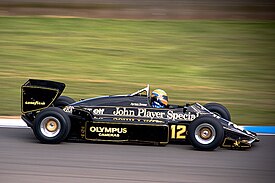Lotus 97T
The Lotus 97T was a Formula One racing car designed by Gérard Ducarouge and built by Team Lotus. A development of the Lotus 95T of 1984, it was designed for the 1985 Formula One season by French engineer Gérard Ducarouge. The 97T was powered by the turbocharged 1.5L Renault engine which produced up to approximately 800 bhp (597 kW; 811 PS). Sponsorship came from John Player Special, French oil company Elf (the official oil of engine supplier Renault) and Olympus Cameras, while the car used Goodyear tyres.
The 97T was of a generally simple design, it used elements from the defunct Lotus 96T Indycar project in the aerodynamics with another piece of Lotus design: an early form of bargeboards. These were placed between the front wheels and the side pods improving airflow around the side of the car. Ducarouge also got around the ban on the 'winglets' seen on the rear wings of the 1984 cars by placing them instead on the rear edges of the side pods.
Lotus' major coup for 1985 was signing rising star Ayrton Senna from the Toleman team to replace long time team driver Nigel Mansell who had signed with Williams. Senna, the first driver signed to the team since the death of Colin Chapman, partnered Italian Elio De Angelis who had finished third in the previous season's drivers' championship and had had many promising results with the 95T.
The 97T proved competitive during the season, taking 8 poles, 7 with Senna and 1 with De Angelis, and 3 wins. Senna's first was a brilliant performance in the Portuguese Grand Prix where he won by over a minute in monsoon conditions. His second came in the Belgian Grand Prix at Spa, held in wet/dry conditions. De Angelis added a third win (his 2nd and last win in F1, both for Lotus) at the San Marino Grand Prix after original winner Alain Prost (McLaren) was disqualified an hour after the race finished due to his out of fuel McLaren-TAG being 2 kg underweight.
The 97T while fast, was mechanically unreliable. The car had the best chassis of any car that competed during that season; it had the best braking and turning capabilities and it also had the best designed suspension of that year; although its aerodynamics were inferior to that of McLaren's car that year. As a result of having the best chassis, it performed best on slow and tight circuits like Monaco, Montreal, Detroit and Adelaide, although the Renault engine had reliability issues and was down on power compared to the competitors of BMW and Honda engines, but about on par with the Ferrari and Porsche units. Senna in particular had a run of bad luck mid season, including a huge crash in the French Grand Prix at Paul Ricard, where he went off at almost 200 mph (322 km/h) going into the Courbe de Signes at the end of the 1.8 km long Mistral Straight; and he retired many times while leading which cost him a possible chance at the world championship. Eventually, Lotus finished fourth in the Constructors' Championship, albeit tied on points with Williams who finished in third place owing to their greater number of race victories.
In total the Lotus 97T scored three victories, two second places and four third places. The car also achieved eight pole positions and three fastest laps.
The car marked the start of a brief return to the successful days of the 1960s and 1970s for Lotus, which was continued by the 98T of 1986 and the Honda-powered 99T of 1987.
Senna's 97T was added to Gran Turismo 6 via the May 2014 update as part of the game's new feature "Ayrton Senna Tribute" in two liveries: the Gold Leaf livery (identical to that of de Angelis's 97T apart from the driver number and name) and an in-game only "Team Lotus Special" livery (which was used instead of "John Player Special" due to tobacco advertising regulations).





![Validate my RSS feed [Valid RSS]](valid-rss-rogers.png)















































































ไม่มีความคิดเห็น:
แสดงความคิดเห็น